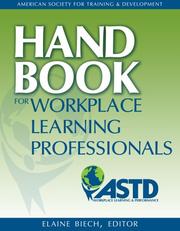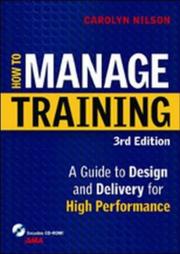| Listing 1 - 10 of 218 | << page >> |
Sort by
|
Book
Year: 2017 Publisher: Washington, D.C. : The World Bank,
Abstract | Keywords | Export | Availability | Bookmark
 Loading...
Loading...Choose an application
- Reference Manager
- EndNote
- RefWorks (Direct export to RefWorks)
Firms that provide on-the-job training do so when it is critical to their productivity-and when productivity is critical to their survival. This paper begins by confirming a significant and positive return from on-the-job training on wages and productivity, as well as the presence of positive externalities from on-the-job training, while discussing the methodological considerations at play. The paper then reviews and validates the presence of market failures such as information asymmetries within the firm as a result of low-quality management practices that dampen firm demand for on-the-job training. Lack of competition in the firm's external environment appears to undermine adoption of on-the-job training and other complementary productivity-enhancing activities within the firm. The literature suggests that for most firms, a comprehensive policy approach that resolves external constraints to becoming more productive is likely to have a positive impact on the provision of on-the-job training and adoption of complementary policies. More direct forms of firm-level support to improve management capabilities could also alleviate under-provision of on-the-job training. Where societies have improved welfare as a goal, public policy measures would be needed to complement on-the-job training for some specific groups of workers (older, less educated, women). In essence, the paper highlights the importance of demand-side constraints for firms, rather than supply-side constraints, for the provision of on-the-job training.
Competition --- Constraint --- Demand --- Employer --- Firms --- Human Capital --- Information --- Management --- On-The-Job Training --- Productivity --- Skills --- Wages --- Workers
Book
Year: 2018 Publisher: Washington, D.C. : The World Bank,
Abstract | Keywords | Export | Availability | Bookmark
 Loading...
Loading...Choose an application
- Reference Manager
- EndNote
- RefWorks (Direct export to RefWorks)
In Kenya, skills constraints are reported to have a detrimental impact on job creation and labor market outcomes. Employers have reported concerns with the level and relevance of a broad set of socio-emotional skills and cognitive skills amongst job applicants and recently hired workers. These skill gaps affect firms' competitiveness (ability to grow and create more jobs), as well as productivity (better wages). Evidence of job dissatisfaction on both the demand and supply side suggests that workers are not being matched with the right jobs. Three policy implication are derived from these results. First, worker mobility and resilience to new challenges requires the continuous upgrading of skills through on-the-job and other training opportunities. Second, with the projected population growth rate (for young people) there is an urgent need to foster high productivity jobs, as well as jobs that are inclusive (to vulnerable populations). Third, in order to address the skills mismatch, comprehensive labor market information is needed to guide students and jobseekers by providing unemployment data, job vacancies and the level of wages by occupation type.
Education --- Educational Attainment --- Labor Market --- Labor Markets --- On-The-Job Training --- Productivity --- Secondary Education --- Skills Development and Labor Force Training --- Social Protections and Labor --- Vocational and Technical Education
Book
ISBN: 020104112X 9780201041125 Year: 1978 Publisher: Reading, Mass.: Addison-Wesley Publishing Company,
Abstract | Keywords | Export | Availability | Bookmark
 Loading...
Loading...Choose an application
- Reference Manager
- EndNote
- RefWorks (Direct export to RefWorks)
Employees --- Personnel --- Training of --- Formation --- Employee development --- Employee training --- Employees, Training of --- In-service training --- Inservice training --- On-the-job training --- Training of employees --- Training within industry --- Vestibule schools --- Occupational training --- Employer-supported education --- Employees - Training of

ISBN: 1562865129 1782687912 1562865706 Year: 2008 Publisher: [Place of publication not identified] American Society for Training & Development
Abstract | Keywords | Export | Availability | Bookmark
 Loading...
Loading...Choose an application
- Reference Manager
- EndNote
- RefWorks (Direct export to RefWorks)
“Authoritative, complete, and current, the ASTD Handbook for Workplace Learning Professionals is an easy-to-use, must-have reference tool for all learning professionals. This 'go to' resource and reference guide, edited by Elaine Biech, is packed full of key methodologies, practices, and procedures on every topic including training design and delivery, analyzing needs, measurement and evaluation, e-learning, organization development, managing the learning function, and human performance improvement. The ASTD Handbook brings together authors who represent the best practitioners in the field, authorities to present the most critical information to professionals. Contributors include Bill Wiggenhorn, Geary Rummler, Robert Mager, Bill Byham, Elliot Masie, Donald Kirkpatrick, John Cone, Donnee Ramelli, Tony Bingham, and other industry leaders. Included in this volume are a complete glossary and a CD-ROM with supporting worksheets and tools.” Note: CD-ROM is not available for this title.
Employees --- Marketing & Sales --- Commerce --- Business & Economics --- Training of --- Computer-assisted instruction --- Employee development --- Employee training --- Employees, Training of --- In-service training --- Inservice training --- On-the-job training --- Training of employees --- Training within industry --- Vestibule schools --- Occupational training --- Employer-supported education

ISBN: 081440779X 0814427170 9780814427170 9780814407790 Year: 2003 Publisher: New York AMACOM
Abstract | Keywords | Export | Availability | Bookmark
 Loading...
Loading...Choose an application
- Reference Manager
- EndNote
- RefWorks (Direct export to RefWorks)
BUSINESS & ECONOMICS --- Training --- Commerce --- Business & Economics --- Marketing & Sales --- Employees --- Training of. --- Employee development --- Employee training --- Employees, Training of --- In-service training --- Inservice training --- On-the-job training --- Training of employees --- Training within industry --- Vestibule schools --- Occupational training --- Employer-supported education

ISBN: 0566086476 9786611098209 1281098205 075468301X 1317116739 1317116747 9780754683018 9780566086472 9781315588537 9781317116721 9781317116738 9780429281785 0429281781 9781000417357 1000417352 9781000417326 1000417328 1315588536 9780367243319 9781032055916 Year: 2022 Publisher: London ; New York : Routledge, Taylor & Francis Group,
Abstract | Keywords | Export | Availability | Bookmark
 Loading...
Loading...Choose an application
- Reference Manager
- EndNote
- RefWorks (Direct export to RefWorks)
"Research conducted over many years suggests that between 60-75% of all information security incidents are the result of a lack of knowledge and/or understanding amongst an organization's own people. And yet the great majority of money spent protecting systems is focused on creating technical defences against often exaggerated external threats. Angus McIlwraith's book explains how corporate culture affects perceptions of risk and information security, and how this in turn affects employee behaviour. He then provides a pragmatic approach for educating and training employees in information security and explains how different metrics can be used to assess awareness and behaviour. Information security awareness will always be an ongoing struggle against complacency, problems associated with new systems and technology, and the challenge of other more glamorous and often short term priorities. Information Security and Employee Behaviour will help you develop the capability and culture that will enable your organization to avoid or reduce the impact of unwanted security breaches. This second edition has been thoroughly updated throughout, incorporating other areas like anthropology and other non-technical disciplines which are making an impact on recent developments. It also explores the technology used to deliver communication, education and awareness, particularly in the areas of online delivery and recent developments such as 'gamification', as well as the ways in which the research, tools, techniques and methodologies relating to the measurement and change of organisational culture have matured"--
Business enterprises --- Information technology --- Employees --- Computer networks --- Security measures. --- Training of. --- Employee development --- Employee training --- Employees, Training of --- In-service training --- Inservice training --- On-the-job training --- Training of employees --- Training within industry --- Vestibule schools --- Occupational training --- Employer-supported education
Book
ISBN: 1855754029 9786612779336 1849408440 1282779338 9781855754027 0429480547 036710556X 9781849408448 9781282779334 6612779330 9780429480546 0429919549 Year: 2009 Publisher: London : Karnac,
Abstract | Keywords | Export | Availability | Bookmark
 Loading...
Loading...Choose an application
- Reference Manager
- EndNote
- RefWorks (Direct export to RefWorks)
Considering how much experience there now is in providing supervisor training in the UK, relatively little has been written about it. This book aims to create a lively and readable resource that will be informative and inspirational for those planning for the future of training for supervisors of counsellors, or who create, teach on or apply for supervisor training. The structure and content will invite reflection on the training issues that the authors address. It is intended to be consciously forward looking in a period of rapid development, and is designed to highlight differences between p
Supervisors --- Employees --- Training of. --- Employee development --- Employee training --- Employees, Training of --- In-service training --- Inservice training --- On-the-job training --- Training of employees --- Training within industry --- Vestibule schools --- Counselors --- Supervision of --- Training of --- Occupational training --- Employer-supported education
Book
ISBN: 1443882135 1443878251 9781443882132 9781443878258 Year: 2015 Publisher: Newcastle upon Tyne
Abstract | Keywords | Export | Availability | Bookmark
 Loading...
Loading...Choose an application
- Reference Manager
- EndNote
- RefWorks (Direct export to RefWorks)
In the modern workplace, millions of dollars are spent each year on employee training. All too often, however, little thought and effort is spent on evaluating training and ensuring that the correct training is taking place. Successful training is about understanding both organizational goals and employee behavior. The basis for this book is the 9th Annual River Cities Industrial and Organizational Psychology Conference held on the campus of The University of Tennessee at Chattanooga in October 2013. The theme of the conference was "Trends in Training". Accordingly, the focus of many of the ta
Employees --- Training of. --- Employee development --- Employee training --- Employees, Training of --- In-service training --- Inservice training --- On-the-job training --- Training of employees --- Training within industry --- Vestibule schools --- Occupational training --- Employer-supported education --- Training of --- E-books

ISBN: 0415316316 0415316308 0203348052 0203571649 128001993X 1134374127 9780203571644 0203338286 9780203338285 9781280019937 9786610019939 6610019932 9780415316309 9780415316316 9781134374076 9781134374113 9781134374120 1134374119 9780203348055 Year: 2004 Publisher: London New York, NY Routledge
Abstract | Keywords | Export | Availability | Bookmark
 Loading...
Loading...Choose an application
- Reference Manager
- EndNote
- RefWorks (Direct export to RefWorks)
As policy makers increasingly focus on workplace learning as a way of improving organizational performance, the debate about the learning organization has grown. Counterbalancing the often over-optimistic assumptions made about the future of work and learning, this book argues that without a contextualized analysis of the field, our understanding of the learning environment is limited. It reconsiders the true role and nature of workplace learning in context.Grounded in original research, the book features case studies which illuminate how the workplace environment can provide both ba
Employees --- Training of. --- Employee development --- Employee training --- Employees, Training of --- In-service training --- Inservice training --- On-the-job training --- Training of employees --- Training within industry --- Vestibule schools --- Occupational training --- Employer-supported education
Book
ISBN: 1607288419 1562865307 Year: 2008 Publisher: [Place of publication not identified] American Society for Training & Development
Abstract | Keywords | Export | Availability | Bookmark
 Loading...
Loading...Choose an application
- Reference Manager
- EndNote
- RefWorks (Direct export to RefWorks)
Understanding business etiquette and protocol intelligence gives professionals an edge. These soft skills may seem inconsequential, but they go a long way toward building your reputation and image. This Infoline is designed for anyone looking to understand the basics of professional etiquette. Readers will learn how to make proper introductions, greet international clients, and navigate business lunches and dinners.
Business etiquette. --- Professional socialization. --- Employees --- Training of. --- Employee development --- Employee training --- Employees, Training of --- In-service training --- Inservice training --- On-the-job training --- Training of employees --- Training within industry --- Vestibule schools --- Occupational training --- Employer-supported education --- Socialization --- Office etiquette --- Etiquette
| Listing 1 - 10 of 218 | << page >> |
Sort by
|

 Search
Search Feedback
Feedback About UniCat
About UniCat  Help
Help News
News